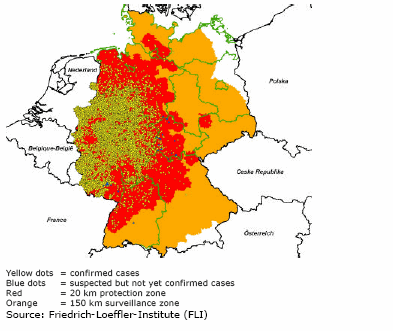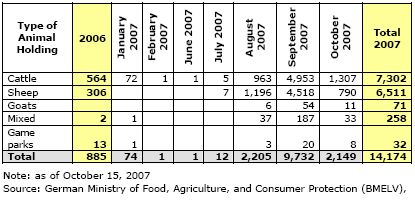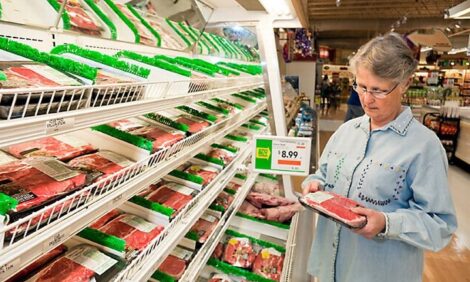



Bluetongue Update: Disease continues to Spread in Germany
This GAIN report by the USDA Foreign Agricultural Service highlights the continuing effects of bluetongue disease on Germany.Report Highlights:
The number of reported Blue Tongue Disease (BT) cases since January 1, 2007 has increased to 14,174, with the majority of cases having occurred in August - October. Currently, there is no vaccine available. The German Research Institute for Animal Health (FLI) hopes that a vaccine could be approved in 2008. The economic impact of BT-8 is highest for sheep farmers. The indemnity program only covers the current value of the animals, replacement costs and disease related reductions in productivity are not covered.
From January 1 through October 15, 2007, Germany reported 14,174 cases of Blue Tongue Disease serotype 8 (BT-8) compared to 885 cases in all of 2006. The first outbreak occurred in North Rhine Westphalia (NRW) close to the border to the Netherlands in August 2006. In the meantime, BT-8 has spread north-, east-, and southwards. The rapid spread suggests that the virus has become endemic in North-West Europe.
Protection and surveillance zones are large (20 and 150 km) compared to other diseases because BT is transmitted through midges (culicoides ssp.) that can be transported by wind over 100 km. Transport of susceptible animals outside of the restricted zones and from the protection to the surveillance zone is only allowed under certain restrictions, as outlined in EU decision 2005/3931,2 and subject to approval by the local veterinary authority. Within the zones, transport is not restricted. Transport to restricted zones in the Netherlands, Belgium, Luxemburg, and France is possible under certain conditions and subject to approval by the local veterinary authority and by the receiving member state.
Currently, most of the German territory falls under a protection or surveillance zone except for the eastern parts of Mecklenburg-Western Pomerania and Brandenburg, and the southern parts of Bavaria (see map below).

BT is a non-contagious viral disease transmitted by midges (culicoides ssp.). The majority of BT cases occurs in the summer and fall because of the biology of its vector. As a result, control measures for BT differ from more highly contagious diseases such as Avian Influenza (AI) and do not involve the destruction of large number of animals.
BT affects ruminants and sheep. While only sheep fall seriously ill, BT may reduce milk production and fertility in infected cows. BT does not affect humans.
BT was first recorded in Germany in August 2006. For details on geographical distribution and affected animal types, please refer to tables 1 and 2.


Currently no vaccine available
The fast spread of the disease has prompted a discussion about control measures. Recently, the German state (Laender) ministers in charge of veterinary issues, have asked the German government to call for an EU wide surveillance plan that includes wild ruminants and to be co-financed by the EU.
Currently there is no suitable vaccine available against BT-8. Active vaccines that are used in South Africa are said to have too many side effects. In addition, it would not be possible to distinguish infected from vaccinated animals, which make disease monitoring and control more difficult and incurs trade restrictions. According to FLI, two EU based companies are working on developing an inactive vaccine. FLI is currently preparing a study to test the effectiveness of one of these vaccines and is hopeful that a vaccine could be approved in 2008.
Economic Impact
Bovines
High impact for breeding animals for export to unrestricted zones. A number of countries do no accept breeding animals originating from a protection or surveillance zone, which effectively inhibits exports to those countries. Even if transport/export is allowed subject to conditions, these conditions add extra costs, which reduce profitability and competitiveness.
Exports in bovine animals to non-EU countries was significantly hampered when BT-8 was first detected in August 2006, because all export certificate became invalid. Some countries, like Russia for example, were quick to develop and accept new export certificates and trade resume quickly, while trade with other countries, for example Algeria, stopped completely.

The impact for movement of other live animals actually decreases, as the zones get larger because transport within the zones is not restricted and transport from the protection to the surveillance zone is possible under certain conditions.
For dairy production, BT reportedly negatively affects productivity (milk production), fertility and the rate of stillbirths. The impact is difficult to assess. Some press report declines in milk production of up to 5 kg per cow and day. For meat production, the effect of BT is reportedly comparable to that of a cold and thus a lot less severe.
While the decrease in milk production can be serious for the individual farmers3, it has not yet significantly affected the German milk production as a whole. At this point, the impact on the German milk production is estimated to be less than 0.1 percent4.
Sheep
Reportedly, the mortality rate for infected sheep can go as high as 80 percent. As a result, sheep farmers are much more impacted by BT than cattle farmers and some fear for their existence. Exports of breeding sheep has stopped almost completely because of BT-8.

Indemnity program
The German Animal Disease Law includes a mandatory insurance-like program (Tierseuchenkasse) for certain animals, including cattle and sheep. By law, all owners of certain animals (livestock, poultry, horses, sheep, goats, farmed game, and bees) are required to register their animals with public authorities and to pay a yearly fee into the program. The annual fee is based on the number of animals and varies by species. Indemnity is granted if an animal dies from a notifiable animal disease or if the official regional veterinarian orders an animal to be destroyed in connection with an animal disease outbreak. Beginning in 2007, BT is included in the list of diseases for which compensation is granted. The amount of compensation is equal to the current value of the animal. It is calculated by the official veterinarian. Replacement costs and consequential losses are not covered, neither are disease related reductions in productivity.
Each state administers its own program and this explains the differences between state policies. While the majority of funds come from premiums paid by the animal owners, some states provide additional funding. Also, in contrast to insurance, the indemnity program cannot go bankrupt. If funds are insufficient, for instance in the case of a major disease outbreak, the government would step in.
Key facts on German Cattle and Sheep production
Preliminary data from the most current animal census for Germany reports 12.7 million cattle, thereof 4.1 million dairy cows, and 2.44 million sheep.
1 http://eur-lex.europa.eu/LexUriServ/site/en/consleg/2005/D/02005D0393-20070302- en.pdf
2 Examples for conditions that have to be met to allow transport out of the zones include but are not limited to a negative BT-8 test, the absence of any clinical symptoms, and a treatment with insect repellents.
3 In 2005, the average milk production per cow amounted to 6761 kg per year or 23 kg per day (based on a 305 day lactation period). Therefore, for the “average cow” a loss of 5 kg per day translates into a 20 percent reduction in production.
4 Calculated based on a 305 day lactation period and the assumption that half of the positively tested cattle were dairy cows, which all would show a 5 kg per day decline in milk production. This would total in a production decrease of about 6000 MT compared to an annual Germany milk production of 27 million MT.
October 2007


